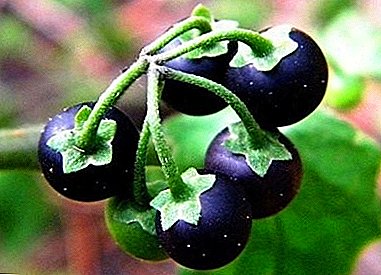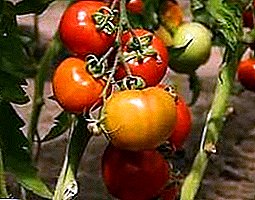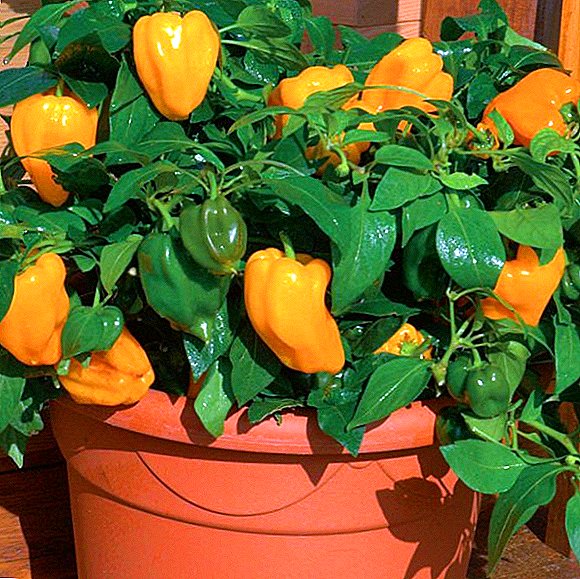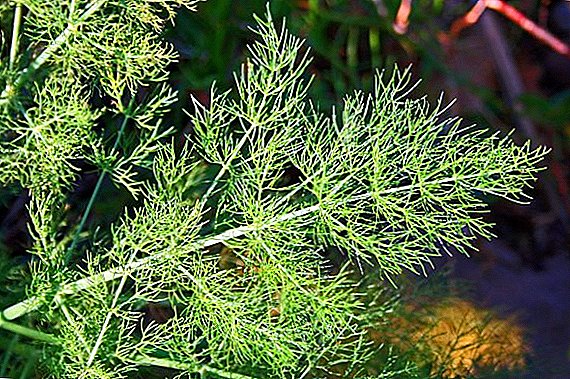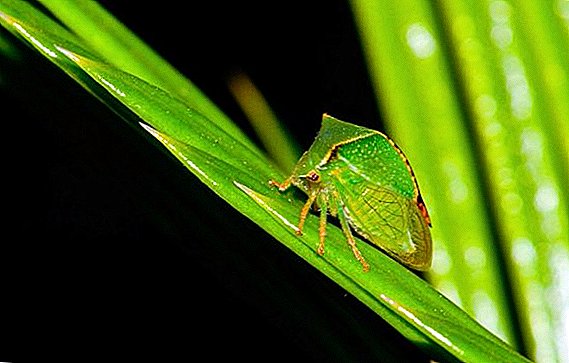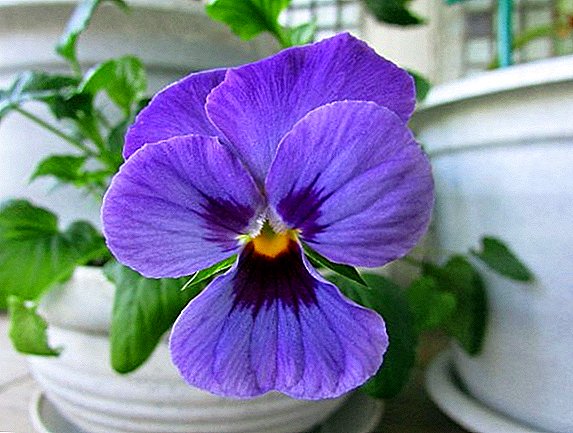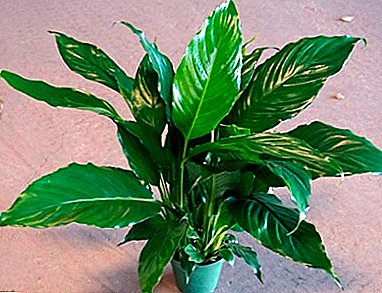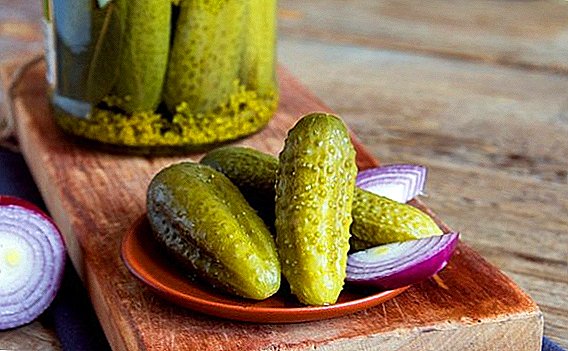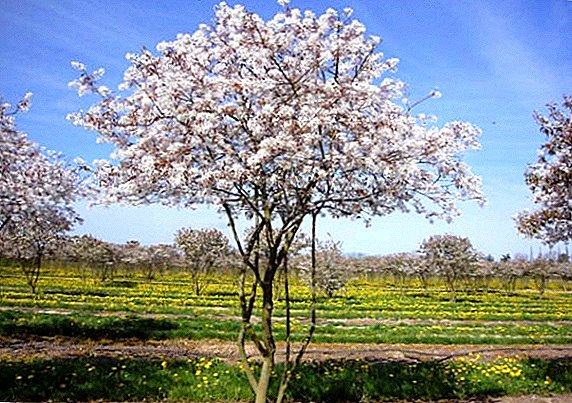 From Europe and America many cultivated plants came to us, many of which we use almost every day. Today we will talk about the fruit shrub, which is used both in the decor and for getting delicious berries. We find out what constitutes Irga Lamarckhow to plant it, and whether there are difficulties in the care, and also consider the possible problems with the shrub.
From Europe and America many cultivated plants came to us, many of which we use almost every day. Today we will talk about the fruit shrub, which is used both in the decor and for getting delicious berries. We find out what constitutes Irga Lamarckhow to plant it, and whether there are difficulties in the care, and also consider the possible problems with the shrub.
Description
Irga - a genus of plants from the family of pink, which are shrubs or small trees.
The plant is also called cinnamon, which is the second official name. It turns out that irga is a whole genus, which is divided first into species and then into varieties. Today we will discuss one of the 28 existing species - Irgu Lamarck.
Like irgu, the pink family includes: felt cherries, kerriju, fieldfare, cherry plum, spirea, cotoneaster and rosehip.
Irga Lamarck - This is a large deciduous shrub whose height reaches 5 meters. It has an umbrella crown, which is formed by massive skeletal shoots. Sheet plates have an elongated shape, toothed at the edges, the length is 4-9 cm, width - 2-5 cm.  Young leaves are painted in a copper-purple color, which eventually changes to green. In autumn, the leaves again become reddish.
Young leaves are painted in a copper-purple color, which eventually changes to green. In autumn, the leaves again become reddish.
Buds are not attractive. During flowering, small white flowers appear that are odorless. Petals of buds reach a length of 1 cm. Flowering occurs in early summer. In late August, edible round fruits ripen on the tree.
The berries are colored purplish-black, but from a distance they appear blue. All fruits are formed on the hanging brushes.
Important! Irgu Lamarck is often confused with the Canadian Irga. The Canadian variety is distinguished by its smaller foliage, berries, and flowers.
The plant is most often used for ornamental purposes, however many owners plant it in the garden in order to get a tasty berry at the end of summer.  Products are very useful, as it contains a large amount of vitamin C, as well as minerals. Berry is used in traditional medicine, therefore it cannot be said that irga is suitable exclusively for decoration.
Products are very useful, as it contains a large amount of vitamin C, as well as minerals. Berry is used in traditional medicine, therefore it cannot be said that irga is suitable exclusively for decoration.
Sorta
Next, we discuss the common varieties of this species that can be grown in our climate.
"Ballerina". The variety was obtained at the Netherlands Experimental Station. It is a fairly tall tree shrub that has a maximum height of 4.5 to 6 m. This variety is distinguished by its large diameter of buds and berries.  Flowers have petals up to 3 cm long. After ripening, berries reach 12 cm in diameter, which is a very good indicator. "Ballerina" has good frost resistance. The variety belongs to the 4th zone of frost resistance, therefore it can withstand a drop in temperature to -34 ° C.
Flowers have petals up to 3 cm long. After ripening, berries reach 12 cm in diameter, which is a very good indicator. "Ballerina" has good frost resistance. The variety belongs to the 4th zone of frost resistance, therefore it can withstand a drop in temperature to -34 ° C.
Familiarize yourself with the features of popular varieties of irgi, and also learn how to grow an algae irga in your garden.
"Princess Diana". American variety that was bred in Wisconsin (USA). It is a slightly sprawling tree, the height of which is not more than 7 m, and its width is 5 m. Like the previous variety, "Princess Diana" has large flowers, whose diameter is up to 2 cm. The fruits also have a large size (up to 1 cm), it should take into account the high yield of the variety.  This variety is cultivated both as an ornamental plant, as it has an interesting yellow color of buds, and as a fruit tree, which gives a considerable amount of production. It is possible to grow "Princess Diana" in our climate, as it can withstand up to -30 ° C inclusively (cold resistance group 4).
This variety is cultivated both as an ornamental plant, as it has an interesting yellow color of buds, and as a fruit tree, which gives a considerable amount of production. It is possible to grow "Princess Diana" in our climate, as it can withstand up to -30 ° C inclusively (cold resistance group 4).
Other varieties that were bred on the basis of this species are either not frost resistant or are used exclusively as an ornamental plant.
Landing
We proceed to the landing irgi on your site. We will discuss the most important points related to the choice of planting material, place and soil.
We recommend you to learn how to plant and grow irgu, as well as what useful properties this shrub has.
Selection of seedlings
Above, we wrote about the fact that this species can be easily confused with the Canadian variety, so you should only buy the seedling on which the leaves are present. Be sure to pay attention to the size of the sheet plates and their color.
You should purchase only those seedlings that are supplied in containers or pots, that is, with a closed root system. In such conditions, planting material retains its viability, its root system does not dry out and does not soak, being exposed to the defeat of the fungus.
It is for this reason that it is worth refusing to purchase young plants in spontaneous markets, where their rhizome is either wrapped in polyethylene or not covered at all, which is why the root system loses all moisture.  Also in the selection process, note the presence of damage. Any damage to the bark can lead to disease and pest damage. If there are leaves on the bush, then be sure to check their turgor - the plates should be tight and elastic. The opposite indicates problems related to both the lack of moisture and the problems of the root system.
Also in the selection process, note the presence of damage. Any damage to the bark can lead to disease and pest damage. If there are leaves on the bush, then be sure to check their turgor - the plates should be tight and elastic. The opposite indicates problems related to both the lack of moisture and the problems of the root system.
Site selection for planting
Irga Lamarck is not whimsical, but this applies only to adult plants. Young saplings should create the most comfortable conditions so that they quickly grow and do not get sick.
Did you know? Like many plants from the family of pink, in an irgi, the fruit is an apple, since the seeds are located exactly in the center of the fruit and are covered with pulp. So do not be surprised if you hear the phrase "irg apples".
Start with a relief. It is recommended to plant a shrub on a flat surface, a small elevation is acceptable. If you plant irgu in a lowland, then its root system will rot due to the constant high humidity, and at elevation the plant will constantly lack moisture.
Lighting. In this case, the compromise is inappropriate, and planting planting material is necessary only in open areas. Irga should receive a maximum of sunlight, especially if you live in the northern part of the allowable climate zone.  Priming. Practically any neutral or slightly acidic soil is suitable, however, preference should be given to fertile sites with a high content of mineral substances in the substrate. It is not recommended to plant on loams or sandstones, as these extremes will have a bad effect on the plant.
Priming. Practically any neutral or slightly acidic soil is suitable, however, preference should be given to fertile sites with a high content of mineral substances in the substrate. It is not recommended to plant on loams or sandstones, as these extremes will have a bad effect on the plant.
Important! Irga does not tolerate soil contamination with chemicals that is worth remembering.
The groundwater. Separately, it should be said that the irga has long roots, so it should be planted in those areas where there is a low occurrence of groundwater, otherwise the rhizome may rot.
How to land
Let's start with the fact that the shrub can be planted both in spring and autumn. It is worth remembering that the planting material, which was sold with an open root system, it is better to plant it in the spring, as it takes more time to acclimatize.
Before planting, the selected area must be dug 12-15 cm deep. In the process of digging close up phosphate and potash fertilizers (40 g each per square). Further actions should be as follows:
- Digging a hole, focusing on the diameter of the root system, as the roots must freely enter the hole. The depth of the pit corresponds to the length of the root system. The bush should be submerged before the root collar, so that it does not rot. Mix the top layer of soil with sand and rotted compost in the proportion of 3: 1: 1. The bottom layer is removed, as it does not differ in value.
- In the resulting mixture of soil, sand and compost, add 1-2 buckets of humus, 150 g of potash and 400 g of phosphate fertilizers, then mix. It is important that the roots do not come into contact with pure fertilizers, otherwise it will cause a burn.
- After preparing the soil mix, we place gravel, broken brick or expanded clay on the bottom of the hole to ensure good drainage.. The thickness of the drainage layer should be about 10 cm.
- From the prepared soil mixture we form a small hill in the center of the hole, on which we will locate the central part of the rhizome. We place a sapling on this hill, then we straighten the roots.
- Slowly fill the hole with soil mixture, slightly tamping it. It is necessary to get rid of emptiness so that the roots are in good contact with the ground. Next, you should pour about 10 liters of water under the bush to saturate the soil with moisture.
- At the final stage, we trim wood. We need to shorten the above-ground part so that no more than 4-5 developed buds remain on each shoot. Such actions are necessary so that the irga will quickly start and grow.

Care
After the correct landing, care should be taken to care for a small shrub. Next, we describe the actions on which depends not only the appearance of the shrub, but also its yield.
Watering and weeding
Irga has long roots that help her get the necessary moisture. For this reason, the culture can withstand drought, but only if it reaches the groundwater. Based on this, we can conclude that it is often necessary to water the plant in the first 5-6 years of life, until the root system reaches the desired mass.
Further watering is carried out exclusively in a strong drought. To do this, use a hose with a spray bar to also moisten the leaf plates.
As for weeding, it is necessary only if you did not carry out mulching of the tree trunk with peat. Then during the rapid growth of weeds, we should regularly weed the square adjacent to the tree.
Read more about how to remove weeds from the garden, which herbicides will help get rid of them, what tool to choose to remove weeds from the roots, what lawn grass will help to destroy weeds, as well as how to deal with weeds with the help of folk remedies.
Fertilization
Fertilizers applied during planting will be enough for a plant for 3-4 years, after which our shrub should be fed annually.
In the fall, in the near-stem circle, departing about 25 cm from the root collar, the following mineral water is added:
- 300 g of superphosphate;
- 200 g of potash fertilizers, which do not contain chlorine.
 Also, together with mineral fertilizers make organic - 1-2 buckets of humus.
Also, together with mineral fertilizers make organic - 1-2 buckets of humus.In spring and early summer, shrubs need large doses of nitrogen, which has a positive effect on the formation of green mass. For this we will use diluted 10% chicken droppings.
Pour about 5 liters after abundant watering. Feed should be done in the evening.
Important! Over time, you need to increase the amount of fertilizer applied, as the needs of the tree increase.
Pruning
Immediately it is worth clarifying a few points regarding trimming. First, pruning is carried out only for 2-3 years after planting (shortening the branches during planting is not taken into account). Secondly, pruning is carried out only before the start of sap flow, otherwise the tree will not transfer this procedure very well.
Since we have a shrub in front of us, and not a tree, it is common for it to let root shoots grow. For this reason, in the first years of cultivation, we need to remove the so-called null shoots that depart from the rhizome. You should leave only a couple of strong shoots, so that the plant does not turn into a huge thickened ball, occupying a considerable area.  Further, when the shrub grows strong enough, we should take care of updating it. For example, if at you 3 escapes depart from a rhizome, then over time they need to be updated, having cut off 3 old, and having left at the same time 3 young.
Further, when the shrub grows strong enough, we should take care of updating it. For example, if at you 3 escapes depart from a rhizome, then over time they need to be updated, having cut off 3 old, and having left at the same time 3 young.
Of course, you should not cut off all the shoots, after which a few years to wait until new ones grow. This process should be controlled, that is, leave a few young shoots, wait until they grow, and then cut off the old ones.
Important! Do not forget that annually it is necessary to carry out sanitary pruning. To be removed sick, dry and damaged branches.
Also pruned are all young shoots. In early spring, you need to cut a quarter of last year's growth, so that the tree is updated. It is also necessary to remove the horizontal processes to make it easier to collect products. Places of cuts on young branches can not be processed, but on the old be sure to lubricate the garden pitch.
Transplantation of adult shrubs
Experienced gardeners know that it is quite difficult to transplant an adult shrub, even if it has small dimensions. However, sometimes there is such a need, so this point should be discussed.
When transplanting an adult bush, it should be borne in mind that for 15-20 years of life, the roots have not only a length of 2 meters, but also the same diameter of the root system. It is advisable to transplant irga, which has not yet turned 10 years old.
In this case, the earthen clod that should be left on the rhizome should have a diameter of 1.25 m. The length of such a coma should be 70 cm. This is due to the fact that the secondary planting is not complex, but much depends on the correct extraction.
After extraction, the shrub is transplanted to a new place without separating the ground. A hole that is appropriate in diameter and depth is preliminarily dug, after which an earthen room is immersed in it. Drainage and pre-feeding are not required. 
Wintering
Immediately it should be said that no shelter is required, so there will be no additional costs. The only thing that should not be forgotten is autumn dressing and foliage removal from under the tree.
A healthy shrub can withstand severe frosts, so it is better to worry about the absence of diseases and pests rather than additional protection from the cold.
Diseases and pests
Let's start with the diseases that can hit the plant.
- Tuberculosis. Fungal disease, which manifests itself in the form of death of the tips of the shoots. Also in the spring on shoots appear red tubercles of small diameter. Infection occurs through cracks in the cortex. Exclusively weak shoots are affected by the fungus. To cope with the disease, it is necessary to cut off all the affected branches in a timely manner, and then treat the shrub bordeaux liquid. You can also use a solution of blue vitriol.
- Gray rot. Again, fungal disease, the characteristic symptoms of which are light brown spots that appear on the berries. Then the stain grows, and the berry rots very quickly. Rotten fruit is painted gray and covered with bloom. Plaque may also be present on leaves and young shoots. Gray spots of irregular shape appear, after which the affected part begins to rot. Control measures: you must first remove all affected shoots, leaves and fruits from the shrub, and then treat them with a fungicide. In case the chemical treatment is impossible, resort to using Bordeaux liquid.
- Phylocystic disease. Another fungal disease that manifests itself in the form of dark brown spots on the leaves. Over time, the stain begins to increase, and its color darkens. To get rid of the disease, you should remove and burn all damaged parts of the bush, and then treat with a fungicide or Bordeaux liquid.
We turn to the pests that parasitize on this particular culture.
- Irgovyy seed This is an insect that looks like a rider. It has a brown body color and transparent wings. Laying white larvae that hibernate in damaged fruit. In order to prevent the emergence or destruction of already existing pests, it is necessary to treat the shrub before flowering with chemical preparations (Karbofos, Fufanon, Actellic).

- The mottled moth. A small butterfly that lays its larvae directly on the leafy plates of the plant. At the end of summer, the larvae begin to destroy the leaves, as a result of which they become covered with dead spots and begin to crumble. To engage in the destruction of caterpillars should be only after harvest. The plant is treated with the same drugs that are used against the seed-eating.

Breeding
Immediately it is worth clarifying that it is impossible to propagate with seeds of a variety, since you will receive a young plant without varietal characteristics. Only species plants reproduce in a generative way.
Seeds. Immediately after harvesting, select over-ripe berries, remove seeds from them, and plant them in open ground to a depth of about 2 cm. It is better to use fertile soil as a substrate in order to get a good percentage of shoots. Sowing is carried out in the fall, after which the mulch is planted with straw or hay.  Seeds of irgi If the seeds germinate in the fall, then you should not make additional efforts and replace them in a separate pot. This is quite normal, seedlings will be able to survive the cold.
Seeds of irgi If the seeds germinate in the fall, then you should not make additional efforts and replace them in a separate pot. This is quite normal, seedlings will be able to survive the cold.
In spring, sprouted plants should be seated to increase the square of the soil available for each bush. Irga, which is 2 years old, is transplanted to a permanent place. In the process of growing seeds, watering should be carried out, weeds should be removed, and also fed with nitrogen.
Did you know? The infusion of irgi flowers is used for cardiovascular diseases, and on the basis of fruits from the 18th century in the USA, they produce irgovoy wine, which is distinguished not only by its bright taste, but also by its benefits.
Cuttings. Cuttings should be cut only from those bushes that are 5-6 years old.To do this, choose the tops of the shoots, and cutting the planting material is carried out in early summer. The length of the cut stalk should be up to 15 cm. It should contain only 2 pairs of upper leaves, the rest should be removed. The lower cut of the cutting is placed for 8-10 hours in the root growth stimulator, then washed under running water, and planted under a slight slope in a fertile substrate.
A soil from a flower shop is used as a substrate, over which a layer of sand is poured. Planted cuttings in a cold greenhouse or a large flower pot. After planting, cover with a "dome", in which you can use a large bottle or a small transparent barrel.
Watering is carried out using a sieve so that the moisture is evenly distributed over the surface. The temperature under the "dome" should not exceed +25 ° C, so do not place the pot in a heated room.  Reproduction by cuttings After 10-15 days the cutting should root. After that, the "dome" is recommended to shoot during the day so that the young plant can breathe freely. A week later, the shelter is completely removed. In the process of cultivation, the soil should be kept slightly damp, avoiding over-wetting or drying out.
Reproduction by cuttings After 10-15 days the cutting should root. After that, the "dome" is recommended to shoot during the day so that the young plant can breathe freely. A week later, the shelter is completely removed. In the process of cultivation, the soil should be kept slightly damp, avoiding over-wetting or drying out.
After a month, cuttings can be planted on the garden, if the weather permits. After planting, the plants are allowed to take root for a few weeks, then they are fed regularly with diluted slurry. A year later, the young plant can be transplanted to a permanent place.
The division of the bush. This method is used in the event that you have planned to transplant an adult bush to a new place. Specially dig up the rhizome, to separate the part of the transplant, it is not necessary, because you once again injure irgu.
Dig a bush in early spring, before sap flow. The rhizome is divided into several parts, after which the above-ground part is cut, removing old shoots. The separated segment must have at least 2 healthy shoots. Damaged roots should be removed.  Dividing bush
Dividing bush
The same applies to damaged branches. Planted in the same way as a young plant. At the same time, do not forget that the soil should be as nutritious as possible, otherwise the separated part may not settle down.
Now you know what Irga Lamarck is, how it differs from other species, and which varieties should be planted in our climatic zone. Remember that the shrub is best propagated by seed or cuttings, as the division of the bush can greatly harm an adult plant. Use our care guidelines to avoid spending money on disease and pest control.




